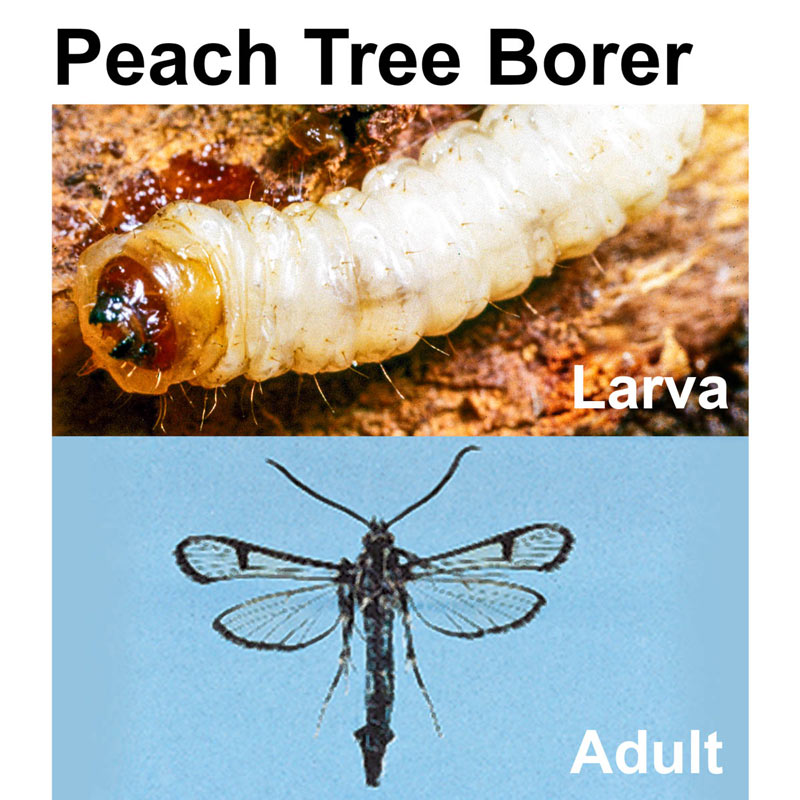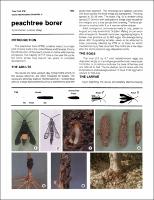peach tree borer life cycle
The period of time required to complete a life cycle varies considerably throughout the range of the peachtree borer. The peachtree borer overwinters as a partly grown larva in its burrow beneath the bark of the tree.

Peach Tree Borer Treatment Control Planet Natural
In 3 to 4 weeks a clearwinged moth emerges leaving an empty pupal skin projecting from the burrow.
. This is in contrast to lesser peachtree borer which may feed on any part of the tree Root feeding leads to reduced crop bearing capacity due to lack of nutrient uptake while heavy trunk feeding can. The lesser borer completes about one and one-half cycles a year. There are four main phases of peach tree development.
Usually they are close to or below ground level. Egg laying begins soon after emergence and mating and larvae tunnel into the bark to feed until the. Each of these phases have.
Adult moths of the lesser peachtree borer emerge from late May through September while peachtree borers emerge from midJune to early September. The dormant phase the flowering phase the fruit phase and the harvest. What are the steps in the life cycle of a peach tree.
The peach tree borer completes one life cycle a year. Larvae eat an exit hole nearly through the bark spin a cocoon and pupate in a small cavity. When mature the larva constructs a cocoon under the bark at or near soil level and pupates.
Life cycles of peachtree borers and lesser peachtree borers. Usually they are close to or below ground level. The larval stage of PTB is an indirect pest of stone fruit trees.
This assumes that youre fertilizing the tree twice per year and that you planted it in the right USDA zone. Peach tree borers overwinter as partially grown larvae in a gallery under the bark. The Peachtree Borer By Elaine Pugh Fairfax Master Gardener male peachtree borer The peachtree borer infects and overwinters in trees from the Prunus genus including cherry apricot nectarine plum prune and peach varieties.
Much of the United States including Texas and Nebraska has one generation per year. The adult peachtree borer is a steel blue to black moth that resembles a wasp. In the spring feeding is resumed and the larval period is completed.
The period of time required to complete a life cycle varies considerably throughout the range of the peachtree borer. Because the egg laying period is so long overwintering larvae vary greatly in size. As temperatures warm up they resume boring and usually complete their feeding in May.
Because the egg laying period is so long overwintering larvae vary greatly in size. Mass of gummy sawdust appears at base of trees. The clear-winged female moths lay their eggs on the bark at the base of tree trunks in mid- to late-summer.
While there are other peach tree pests including leafhoppers white peach scale mites and aphids none. It is reported that it takes two years to complete a life cycle in Canada and in a small percentage of populations in New York. Only the immature larva stage Figure 3 produces the damage to trees.
The peachtree borer overwinters as a partly grown larva in its burrow beneath the bark of the tree. BIOLOGY AND LIFE CYCLE. It is reported that it takes two years to complete a life cycle in Canada and in a small percentage of populations in New York.
Life Cycle and Damage. This borer can girdle and kill a. Produced by peachtree borer.
Damage Any wound on stone fruit trees may cause gum to exude. Life Cycle of a Peach Tree Borer. Winter is spent as a larva under the bark in the cambium layer.
The adult borer emerges in the late spring and early summer. Life Cycle and Damage Peach tree borers overwinter as partially grown larvae in a gallery under the bark. Much of the United States including Texas and Nebraska has one generation per year.
In the spring feeding is resumed and the larval period is completed. The lesser peachtree borer overwinters as larvae and reaches full growth during April and May. Larvae tunnel primarily into the lower trunk and roots feeding on growing tissue and inner bark.
The presence of small particles of wood and bark within the gum distinguish damage by peachtree borer Life History and Habits The life cycle of the peachtree borer requires one year to complete. Upon hatching from the eggs Figure 4. Lesser peachtree borers Synanthedon pictipes.
A standard peach tree might grow to be 20 feet tall. It is reported that it takes two years to complete a life cycle in Canada and in a small percentage of populations in New York. Life Cycle The period of time required to complete a life cycle varies considerably throughout the range of the peachtree borer.
Peach plum apricot cherry and other fruit trees. Borer damage is usually attended by gumming with varying amounts of frass in the gum. Borers chew inner bark of lower tree trunk.
Larvae hibernate in tree burrows or in soil. Hatching larvae tunnel into the tree at or slightly below ground level. One generation a year.
LPTB are clearwing moths native to North America and capable of causing economically significant damage to peach cherry plum nectarine and apricot treesAdult LPTB strongly resemble small wasps having dark blue bodies with yellow bands on the second and fourth abdominal segments and transparent wings. They pupate in burrows or in brown cocoons in the soil. In the spring feeding is resumed and the larval period is completed.
Peachtree Borer Wsu Tree Fruit Washington State University

Peach Tree Borer Fairfax Gardening

Lesser Peachtree Borer Damage Stock Image C025 7085 Science Photo Library

Lesser Peachtree Borer Nc State Extension Publications

Peach Tree Borers How To Control Peach Tree Borers
Pests Bc Tree Fruit Production Guide

Peachtree Borer Nc State Extension Publications

Peachtree Borer 5 566 Extension
Pests Bc Tree Fruit Production Guide
Eny 691 In489 Peachtree Borers In The Home And Commercial Peach Orchard

Peachtree Borer Nc State Extension Publications

Peach Tree Borer Trap Pest Control From Gardens Alive
Pests Bc Tree Fruit Production Guide

Greater Peachtree Borer In The Landscape Nc State Extension Publications



